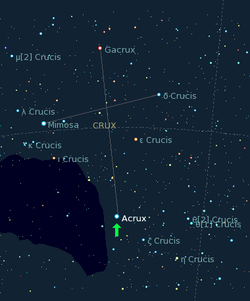| Revision as of 01:57, 2 September 2006 editGoldfinger820 (talk | contribs)1,558 editsm add NZ← Previous edit | Revision as of 17:44, 15 September 2006 edit undoChangeup (talk | contribs)68 editsNo edit summaryNext edit → | ||
| Line 29: | Line 29: | ||
| '''Acrux''' (α Cru / α Crucis / ] Crucis) is the brightest star in ] ] (the Southern Cross) and the ] in the nighttime sky, at ] 0.77. | '''Acrux''' (α Cru / α Crucis / ] Crucis) is the brightest star in ] ] (the Southern Cross) and the ] in the nighttime sky, at ] 0.77. | ||
| It is known as 十字架二 (the Second Star of the Cross) in Chinese. | |||
| The Acrux is represented in the flags of ] and ] as one of the 5 stars that comprise the ]. | The Acrux is represented in the flags of ] and ] as one of the 5 stars that comprise the ]. | ||
Revision as of 17:44, 15 September 2006
 The position of Acrux. | |
| Observation data Epoch J2000 Equinox J2000 | |
|---|---|
| Constellation | Crux |
| Right ascension | 12h 26m 35.9s |
| Declination | −63° 05' 57" |
| Apparent magnitude (V) | 1.40/2.09 |
| Characteristics | |
| Spectral type | B0.5IV/B1V |
| U−B color index | −1.03 |
| B−V color index | −0.08 |
| Variable type | ? |
| Astrometry | |
| Radial velocity (Rv) | −11.2 km/s |
| Proper motion (μ) | RA: −35.37 mas/yr Dec.: −14.73 mas/yr |
| Parallax (π) | 10.17 ± 0.67 mas |
| Distance | 320 ± 20 ly (98 ± 6 pc) |
| Absolute magnitude (MV) | −4.19/−3.79 |
| Other designations | |
| α Crucis/α Crusis, HR 4730/4731, CD -62°2745, HD 108248/108249, SAO 251904, FK5 462, HIP 60718. | |
| Database references | |
| SIMBAD | data |
Acrux (α Cru / α Crucis / Alpha Crucis) is the brightest star in constellation Crux (the Southern Cross) and the thirteenth brightest star in the nighttime sky, at visual magnitude 0.77.
It is known as 十字架二 (the Second Star of the Cross) in Chinese.
The Acrux is represented in the flags of Australia and New Zealand as one of the 5 stars that comprise the Southern Cross.
Since Acrux is at roughly −60° declination, it is only visible south of the Tropic of Cancer and therefore didn't receive an ancient traditional name; "Acrux" is simply a combination of the A in Alpha plus Crux. Acrux is the southernmost first magnitude star, just a bit more southerly than Alpha Centauri.
Acrux is a trinary star located 320 light years from the solar system. Only two components are visually distinguishable, α and α, separated by 4 arcseconds. α is magnitude 1.40 and α is magnitude 2.09, both hot class B (almost class O) stars, with surface temperatures of about 28,000 and 26,000 kelvins respectively; their respective luminosities are 2,500 and 1,600 times that of the Sun. α and α orbit over such a long period that motion is only barely seen. From their minimum separation of 430 astronomical units, the period is at least 1500 years, and may be much longer.
α is itself a spectroscopic binary star, with its components thought to be around 14 and 10 times the mass of the Sun and orbiting in only 76 days at a separation of about one astronomical unit. The masses of α and the brighter component of α suggest that the stars will someday explode as supernovae. The fainter component of α may survive to become a massive white dwarf.
Another class B subgiant lies 90 arcseconds away from triple Acrux and shares Acrux's motion through space, suggesting it may be gravitationally bound to Acrux. However, if it is indeed located near Acrux, it is under-luminous for its class. It is probably just an optical double star, most likely lying over twice as far away from the solar system as Acrux.
Categories: